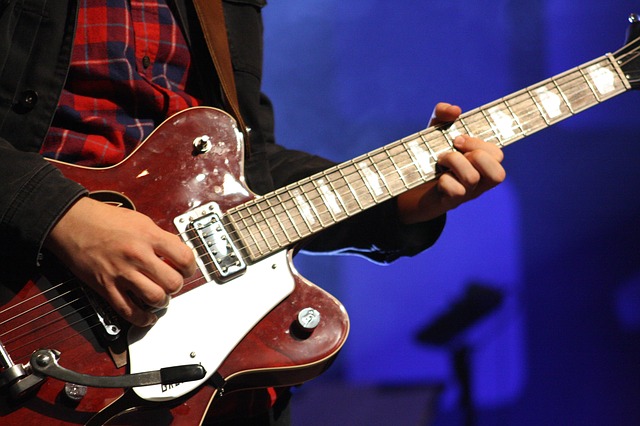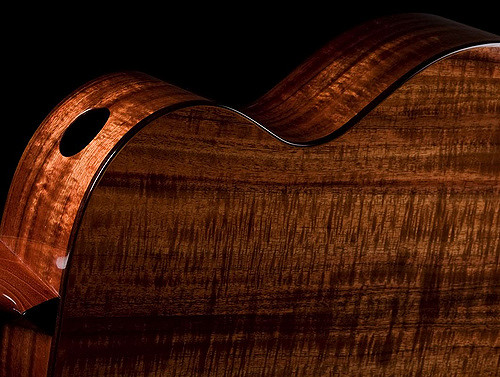When I was younger, I used to believe that in order to be a good musician, you had to do everything yourself. For my inexperienced soul, using different devices was cheating. This sounds really weird and awkward now, but back in the day I could not understand one major factor: it does not matter how you create the music, only the final results speak volumes.
After realizing that, I started exploring various pedals, one of them being loopers. I am not exaggerating when I am saying that they changed my life. How exactly, you might wonder. They helped me perfect my tone (more on that below) and discover the part of myself I never knew existed. This effect is definitely not for everyone, but for those who love the taste of repeating sounds, keep on reading in order to find the best looper pedal on the market.
What’s The Best Looper Pedal
BOSS Audio RC-3 Loop Station Pedal

When it comes to BOSS, one thing that does not change from model to model is the quality. RC-3 is built like a tank and will withstand anything. Unlike its predecessors, this one has a stereo system with double inputs and outputs. This pedal has a vast amount of memory, meaning that you can save up to three hours of your music with the help of 99 memory locations. The latter can be chosen with two simple buttons. Another one lets you lock the sound in the desirable memory spot. The most useful feature of RC-3 is its Tap Tempo, which allows you to adjust the tempo of each loop and avoid arrhythmical performance. The Output control modifies the level of the effect. RC-3 provides an additional input jack that allows you to connect a separate footswitch, enabling you to independently control the Stop and Memory Shift functions. When it comes to performance, this pedal delivers a natural and well-defined sound. With its sturdy construction and high-quality tones, it offers everything you could possibly desire.
Pros:
- A compact design
- Extremely durable
- A lot of memory
- Versatile effects
Cons:
- Can develop a bit of noise
- Limited drum patterns
TC Electronic FlashBack Delay & Looper Guitar Delay Pedal
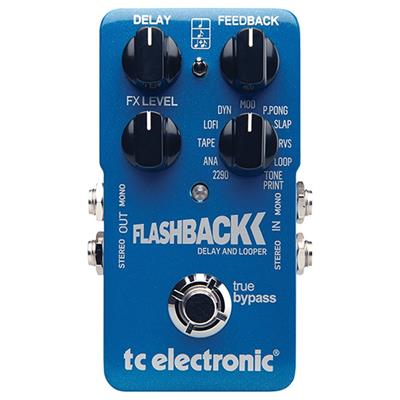
As you may have already guessed from the name, this pedal is a two-in-one deal. TC Electronic FlashBack offers delay and looper, which can be easily controlled. This pedal comes with 11 delay modes (including Tape, Analog, 2290 emulations and etc.) which can be altered with a twist of a knob. It also offers a looper, which can save up to 40 seconds of footage. Distinguishing factor of this pedal lies in its unique tempo control. Featuring an innovative Audio Tapping capability, it empowers you to establish the effect’s rhythm simply by strumming your guitar. Additionally, FlashBack has 3 delay subdivisions, offering a quarter note, dotted eighth and combination modes. If you have used the pedals from TC Electronic before, you probably know about the TonePrint. It is basically an app that can be connected to the pedal in order to tune in even more effects and get more control. All in all, FlashBack sounds amazing and offers a lot of versatility.
Pros:
- Good quality
- Extremely versatile
- Two pedals in one
- Powerful sound
Cons:
- Takes time to adjust to using strums instead of tap tempo
- Subdivisions cannot be modified on the fly
VOX VLL1 Guitar Looper Multi Effect Pedal
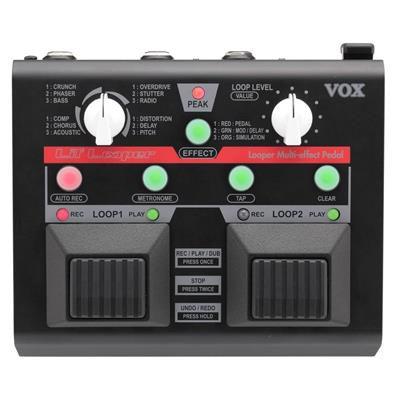
Vox made its name when it introduced the first amplifiers and a lot of time has passed since then, but the quality of this brand has never been shifted. Lil’ Looper is no exception – it’s one of the best looper pedals you can get. It comes with two different looping options (with 90 seconds of recording in total), which can be layered on top of each other. This pedal offers 12 effects (Comp, Crunch, Overdrive, Distortion, Chorus, Phaser, Mod Delay, Stutter, Acoustic, Bass, Radio, and Pitch) that can be added to the loops continuously. These effects can be layered with the help of overdubbing features while maintaining the clarity and quality of the original tones. Microphone input and headphone output make this pedal shine. And the best part is, all these cool options are delivered through a compact design, which saves up a lot of space on your pedalboard.
Pros:
- Versatile features
- Wide range of effects,
- Lightweight
- Dual loops
Cons:
- Does not have a loop storage
- A bit pricey
Electro-Harmonix 720 Stereo Looper Pedal

EHX 720 is everything you could wish for. It features all the essentials and provides you with quality sound as well as ease of use. Let’s dig deep and discuss each of them individually. To begin with, this pedal boasts stereo capabilities, allowing you to simultaneously connect and play two separate instruments. Furthermore, it features an extra input specifically designed for connecting a three-button controller. Secondly, EHX 720 offers 12 minutes of recording with 10 loops, which lets you overdub and redo/undo continuously. It comes with two footswitches, allowing you to start and stop your looping conveniently. Last but not least, this pedal has a Level knob (controls the volume of your output), Reverse and ½ Speed effects (do exactly what their names indicate), and a Push: Mode. The latter lets you switch between Loop Select, Loop Progress, and Loop Fadeout modes. Even though EHX 720 is not very compact, it offers so much control and simplicity, it is hard to say no to.
Pros:
- Easy to use
- Powerful sound
- Versatile controls
- Effects and modes
- Good quality
Cons:
- A bit big (might be an issue for some)
TC Electronic DITTO X2 Looper
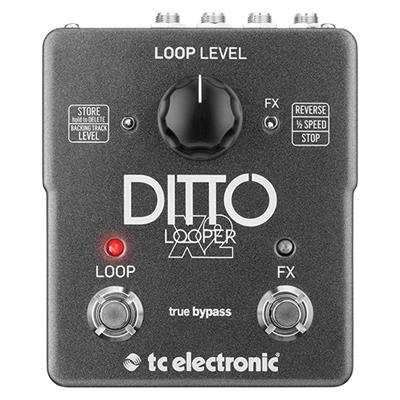
DITTO X2 is an improved version of its predecessor. It offers the same quality of sound but has added features that deliver more precision. The original pedal was famous for its simplicity, which is still maintained in DITTO X2. It has two footswitches labeled Loop and FX. The former is extremely flexible and versatile: tapping it once will start the recording, pressing it again will cause the loop to playback, consecutive taps will activate an overdubbing function, pressing and holding will result in undoing/redoing the last part of the footage, tapping it twice will stop the recording. When it comes to FX, you have several options. Above, it has a toggle, which allows you to switch between Stop, ½ Speed, and Reverse. FX will respond according to the function you choose with the toggle. You can tweak the level of the loops with Loop Level (with a switch, that sets the volume of either the whole piece or the backing track). Additionally, the DITTO X2 offers a recording duration of 5 minutes, a modest length that caters to the needs of most musicians. With this pedal, you can rest assured that your performance will be captured in impeccable quality.
Pros:
- Simple controls
- Separate stop switch
- Reliable
- Sturdy
Cons:
- You can play merely one backing track at a time
- Limited memory slots
Digitech JMEXTV JamMan Express XT Compact Stereo Looper Pedal

Digitech Express XT is part of the JamMan series. Right off the bat, this pedal does not have any internal memory. Neither does it have USB support. Basically, all you have is 10 minutes of stereo looping. This might be an issue for some but if you do not want to play a two-hour-song and loop on top of it, you will be fine. Express XT is quite easy to operate: Recording, Overdubbing, and Playing can be managed by the footswitch itself; the main knob -Loop Level – modifies the volume of the output. The pedal is equipped with multiple LEDs to make sure that you know what you are doing. Just like other loopers, this one also has Undo/Redo functions, but their usage is limited due to the lack of memory. In addition, it offers “Silent Clear”, meaning that you can stop the playback and erase the segment you want. The feature that makes this pedal special is its JimSync function, meaning that you can connect the loopers from the JamMan series to each other and create an entire piece as a whole. Express XT has a bunch of great qualities that make this pedal noticeable among the crowd.
Pros:
- Reliable
- A LOT OF overdubbing
- Compact design
- Simple
Cons:
- Lack of features
- Limited amount of memory
NUX Loop Core Guitar Effect Pedal
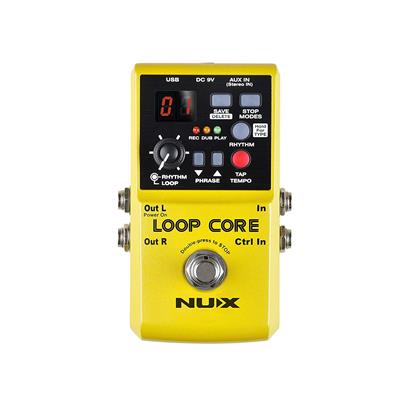
NUX Loop Core is a great bang for the buck. This is a quality pedal with a sturdy and durable body. Apart from that, this one is a stereo, which means you can stream two instruments simultaneously. The recording time it offers is jaw-dropping: you have the option of storing 6 hours of looping in 99 memory slots! This is really surprising considering the price of the device. What is more, NUX Loop Core has a Tap Tempo button, allowing you to control the rhythm of your loops. It has a single footswitch (which starts and stops the looping process), but a number of tweakable options that offer additional control. This pedal has separate Save/Delete, Stop, and Rhythm buttons, with the latter delivering 40 drum patterns. The Rhythm Loop knob adjusts the level of your individual rhythms. NUX Loop Core can be connected to the PC for saving the loops or importing additional ones into the pedal.
Pros:
- Great quality
- Offers a lot of drum patterns
- Versatile
- Very easy to use
Cons:
- The quality of recording is not that great
- Does not have a display for tempo
Digitech JMSXT JamMan Solo XT Stereo Looper/Phrase/Sampler Pedal
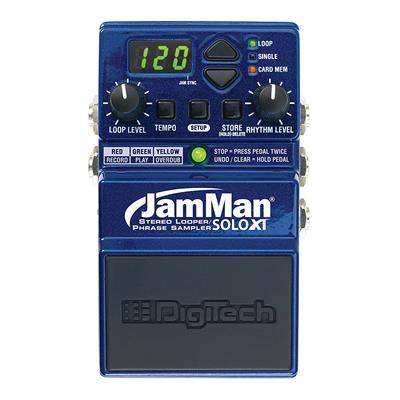
This is yet another proud member of the JamMan series. Solo XT can record up to 35 minutes of looping using 200 memory slots. This is generally enough for most, but in case you want more, you can insert an SD memory card (32GB) into a pedal and add even more room for storing your pieces. This pedal has an auxiliary input that allows you to transfer music from mp3. It can be connected to a computer as well. What is more, Solo XT has a Jam Sync function, which lets you plug in another JamMan looper. You can choose between two modes: Free Form and Auto-Quantized. The former adjusts the rhythm according to your presses, while the latter assists you in that process and balances out any uneven tempos. Time-Stretching allows you to play your loops at super slow/fast speed. Just like other pedals, Solo XT comes with Undo/Redo, Delete, Store, Record, and Reverse features, which are quite essential for clear and precise performance. This pedal boasts two level knobs, namely Rhythm and Loop, which effectively control the output volume and ensure a flawless and seamless audio experience. In essence, it caters to your profound cravings, leaving nothing to be desired.
Pros:
- Vast amount of recording time
- A lot of memory
- Flexible and versatile
Cons:
- A bit hard to use in live setting
- Takes time to adjust
Electro-Harmonix 360 Nano Looper Guitar Looper Pedal
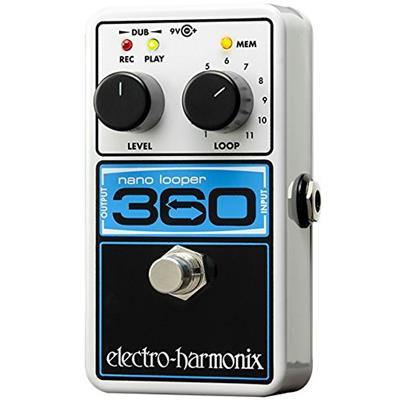
And we are back to Electro-Harmonix. This one takes simplicity to a whole new level. EHX 360 is super easy to operate. It has two main knobs. The first one (Level) adjusts the volume of the effect, while the other (Loop) lets you choose from 11 memory slots. This pedal is equipped with LED lights that indicate each and every operation you make. This will be especially beneficial for those who perform on stage. Apart from that, EHX 360 offers 6 minutes of recording time, which is relevant enough for most guitarists. It saves your loops automatically, so you do not have to worry about your pieces getting lost. You can easily undo/redo, overdub, and clear loops with this pedal. EHX 360 does stand out among its Nano friends, offering a lot for its compact size and affordable price. Looping has never been easier!
Pros:
- Great sound quality
- Reasonable memory space,
- Compact design
- Very easy to operate
Cons:
- Not steeped with features
- Not very versatile
Donner Deluxe Looper Guitar Effect Pedal Loop Station
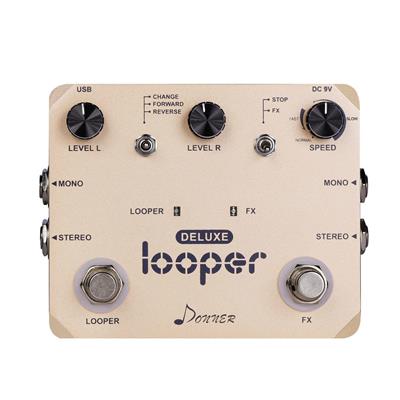
When speaking of Donner, the first thing that comes to mind is the affordability of their products. Deluxe Looper has all the essential features and more. It has three tweakable modes: Change, Forward, and Reverse. They allow you to add a unique touch to your loops and produce jaw-dropping sounds. What is more, this is a stereo pedal, meaning that it has double inputs and outputs, each of them equipped with separate Level knobs. Deluxe Looper has two footswitches, one of them specifically for Stop/Clear functions. Plus, you can create a Backing Track, which will be a great addition to your solo performances. This pedal offers 10 minutes of recording time with unlimited overdubs. You can connect this bad boy to your computer in order to import/export some tracks. Donner Deluxe is not the best looper pedal of all time but for the price, it does its job pretty well.
Pros:
- Transparent sound
- Great quality
- Easy to use
Cons:
- Speed knob affects the pitch of the sound
- Does not have fancy features
The qualities a perfect looper pedal should have
Loop pedals are those devices that can change your performance drastically. They add rhythm and repetition to your sound – the qualities highly desirable during the last couple of decades. A single loop pedal can turn your solo performance into a band-like one, making your music richer and more textured. In order to achieve all these effects, you have to look out for certain features that even the simplest loop pedal should have. I will discuss some of them below and, hopefully, assist you in understanding what makes up a quality stompbox.
First things first: the sound that is recorded or delivered must be natural, without any artificial characteristics. This means that the pedal of your choice should be able to produce clear sound without any kind of sonic interference. So, it is very important to have a quality recording on hand.
Moving onto your preferences. Are you looking for a one-trick pony or a jack of all trades? The answer to this question will quickly define what kind of pedal you should look for. You might want a simple looper that does its job well or require additional features (such as tap tempo, reverse, rhythm control and etc.) that provide more control. One way or another, there is a pedal for every taste. Just think carefully about your aspirations and preferences and make a decision accordingly. Do not forget, though, that more features mean more color and interference with your tones.
Nevertheless, there are some general qualities that should never be overlooked. Some of them are so essential that it is rather hard to achieve the desired sound without them. For example, a single knob that supposedly tweaks a lot of parameters will not give you the control you need. This means that you might have to spend a bit more. However, features such as durability and versatility will let you get your money’s worth. After all, we want to splurge on items that will not give up on us in the middle of the performance.
Now, let’s dig even deeper and find out, to what extent different things matter.
Loop Length
This is probably one of the most controversial subjects. When discussing the individual pedals, I have outlined several times that you do not need that much of recording time. Let’s be honest, we usually play a one-minute piece and loop on top of it. In that sense, even the most basic 6 minutes will be plenty. Just in case you do want to record more, there are pedals that offer up to 35 minutes of recording. Once again, take all the features personally and determine how much length you actually need during a performance.
Loop Storage
As far as I am concerned, I do not want my footage to get lost. If you are anything like me, you will probably be disappointed with pedals that erase the loops as soon as you switch them off. Fortunately, many pedals nowadays come with internal storage and an array of memory slots. In some cases, it might be possible to insert an SD memory card in your pedal or simply connect it to your computer and store your masterpieces there.
The number of footswitches and their importance
In the world of pedals, the quantity of footswitches matters the most when it comes to loopers. At first glance, this is too much to ask for, but if you think about it, it all comes down to making your job easier. This means that one footswitch will still allow you to create the effect you want, you will just have to learn how to tap it like a pro. Such kind of pedals lay a lot of responsibility on the shoulders of the footswitch. It has to start and stop the recording, set the rhythm, activate undo/redo functions or even erase unwanted sections. Thus, you have to try harder as well. Every mistaken tap might ruin your tone a great deal. So, if you want to avoid all this fuss, go for multiple footswitches. In the latter case, the job of controlling different features of your sound is divided, making it way easier to grasp what you are doing. In short, if you are on a budget, you probably will not be able to get your hands on this fancy multi-footswitch pedal, but if you are willing to pay an extra buck, you will not regret even a penny. After all, nobody wants to bust their heads about every tap during the performance. We want that process to be enjoyable because music is not about thinking – it is about feeling every single note you deliver.
Mono vs Stereo Looper Pedals
If you have taken a look at the list above, you have probably noticed that stereo nature of the pedal is always outlined. To put it simply, stereo pedals are “cooler” and give you more options for experimenting and improvising. They allow you to plug in two amps or microphone (or any other device of your choice) to your pedal with the help of double inputs and outputs. This means that you can create amazing loops that will be saturated with character and personality. If you want something simple, though, mono pedals might be more suitable for you.
Additional effects
The majority of advanced looper pedals offer several effects that change your loop up a bit and add versatility to it. Reverse, ½ speed or forward can be interesting for some. Once again, this is a matter of taste. Some might be fed up with “typical” loops and want something different, while others might get bored with effects soon and not even remember them after a while. In my opinion, it is always good to have some options. Look at the subject this way: if you do not feel like using an effect, just don’t. But it is better to have them on hand than having to purchase a new pedal every time you decide to change something in your loops.
How to use a looper pedal
It is important to note that none of the things we mentioned above will matter unless you know how to use your loop pedal. First of all, let’s discuss different setups you could utilize. If you play an acoustic guitar, things are very simple: your guitar à looper pedal à amplifier (or headphone). Things get a bit more interesting in case of electric guitars. You can add looper pedal to your chain, but it is advisable to place it at the end (or towards the end). You might want to add a tone-shaping pedal (like a volume pedal) afterward for clearer sound. One way or another, looper pedals will turn you into a single-man band and can assist you during live performances with a lot of backing tracks and repeating sections.
Apart from gigs, looper pedals can be utilized for practice. If you are a beginner and have a hard time nailing the rhythm of your sound, this might be a great solution to your problem. Plug in a looper pedal, play and replay your pieces until you can discern the mistakes you have made. What is more, many pedals allow you to import sounds, which means you can play your favorite song at a slower rate and get every note right.
Last but not least, loopers can activate your creativity. They are so easy to experiment with and even the single loop can change your music in a unique way. It is possible to come up with a new composition even while playing with the pedal. Do not be afraid of stepping out of your comfort zone – the more risks you take, the more innovative your sound will be. How do you think this effect was created? Musicians, who were willing to try new things, came up with the idea of using different devices in order to produce looping sound. They utilized tape recorders for creating rhythmical repeats. Shortly after the introduction of pedals to the market, the effect became even more popular. My advice to you: listen to the music of legendary guitarists (Les Paul, Robert Fripp), who were way ahead of their time and did their best to deliver special sounds to their audiences. Take an example from them, lose yourself in music and who knows, maybe one day you will be the legendary musician yourself!
Conclusion
In conclusion, I believe that each of you will define the best looper pedal differently. This stands to reason since we all have our individual preferences. Apart from all the things I have mentioned, your skills play a huge role in purchasing a pedal. If you are a beginner, take small steps, start from simple pedals and upgrade gradually. Whether you follow this advice or not is completely up to you. Just keep in mind that those fancy features might confuse you at first. However, anything is possible with the right determination. The main thing is to let go of your fears and devote yourself to the magic of creation.

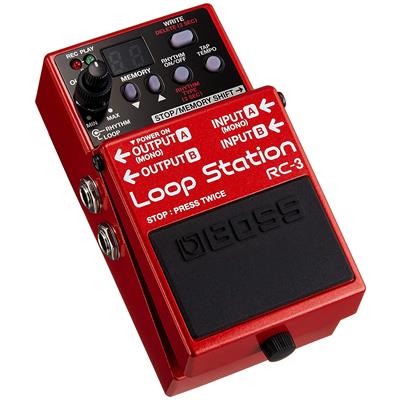
 (5 / 5)
(5 / 5) (4.9 / 5)
(4.9 / 5) (4.8 / 5)
(4.8 / 5) (4.7 / 5)
(4.7 / 5)


